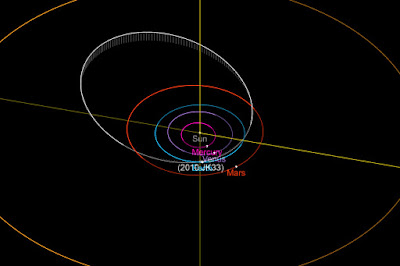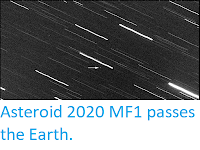Asteroid 2010 JK33 passed by the Earth at a distance of about 17 264 000
km (44.9 times the average distance between the Earth and the Moon, or 11.5% of the distance between the Earth and the Sun), at about 11.45 am
GMT on Sunday 5 July 2020. There was no danger of
the asteroid hitting us, though were it to do so it would not have
presented a significant threat. 2010 JK33 has an estimated
equivalent
diameter of 110-340 m (i.e. it is estimated that a spherical object
with
the same volume would be 110-340 m in diameter), and an object of this
size would be predicted to be capable of passing
through the Earth's
atmosphere relatively intact, impacting the ground directly with an
explosion that would be 600-88 000 times as powerful as the
Hiroshima
bomb. Such an impact would result in an impact crater roughly 1.4-5.0 km
in
diameter
and devastation on a global scale, as well as climatic effects that
would last decades or even centuries.
The orbit of 2010 JK33, and its current position. JPL Small Body Database.
2010 JK33 was discovered on 6 May 2010 by the
University of Arizona's Mt. Lemmon Survey at the Steward Observatory on Mount
Lemmon in the Catalina Mountains north of Tucson. The designation 2010 JK33
implies that the asteroid was the 802nd object (asteroid K33 -
in numbering asteroids the letters A-Y, excluding I, are assigned
numbers from 1 to 24, with a number added to the end each time the
alphabet is ended, so that A = 1, A1 = 25, A2 = 49, etc., which means that K33 = (24 x 33) + 10 = 802) discovered in the first half of May 2010 (period 2010J).
2010 JK33 has a 1217 day (3.33 year) orbital period, with an elliptical
orbit tilted at
an angle of 4.04° to the plain of the Solar System which takes in to
0.87 AU from the Sun (87% of the distance at which the Earth orbits the
Sun) and out to 3.59 AU (359% of the distance at which the Earth orbits
the sun and more than twice as far from the Sun as the planet Mars).
This means that close
encounters between the asteroid and Earth are fairly common, with the
last thought to have happened in July 2010, and the next predicted
in July 2020. It is therefore classed as
an Apollo Group Asteroid (an asteroid that is on average further from the Sun
than the Earth, but which does get closer). As
an asteroid probably larger than 150 m in diameter that occasionally
comes within 0.05 AU of the Earth, 2010 JK33 is also classified
as a Potentially Hazardous Asteroid.
2010 JK33 also
has occasional close encounters with the planets Vunus, which it is next predicted to
pass in April 2067, Mars, which it is next predicted to
pass in August 2056, Mars, which it is predicted to pass in December 2036,
and Jupiter, which it last came close to in July 1955 and is
expected to pass again in November 2038. Asteroids
which make close passes to multiple planets are considered to be in
unstable orbits, and are often eventually knocked out of these orbits by
these encounters, either being knocked onto a new, more stable orbit,
dropped into the Sun, knocked out of the Solar System or occasionally
colliding with a planet.
See also...
Follow Sciency Thoughts on Facebook.







